Enterprise Risk Management
Risk Management in Context
Risk-taking of a holding company is driven by the risk-taking of its component companies, as profits mainly come from its investment in them. GT Capital’s Risk Management practice is designed to anticipate potential risks in the various businesses it invests in, identifying risks in the business landscape classified under Table 1 “Risk Universe and Taxonomy”. The Risk Taxonomy of the organization covers the External Risk Drivers which increases the exposure to certain types of risks the company has identified as material. External drivers are classified under (a) Economic (b) Regulatory (c) Industry Specific Developments (d) Geopolitical (e) Environmental or Climate Risk and (f) Digital Economy. The process encourages a forward-looking and proactive mindset for Risk Managers within the group.
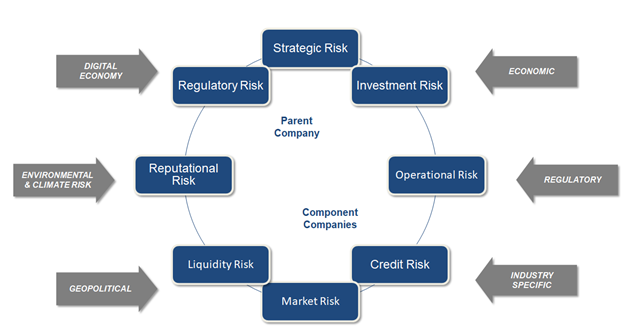
Risk Universe & Taxonomy
Risk Management Building Blocks
GT Capital’s Risk Management recognizes the importance of establishing a solid foundation for different areas of the Risk Management practice. In order to promote a strong and effective Risk Management, the following building blocks are key focus areas.
- Risk Governance & Oversight
- Risk Management Function
- Risk Management Practices, Policies & Processes
- Risk Culture
- Risk Appetite & Strategy

Building Blocks of Enterprise Risk Management (ERM)
Enterprise Risk Management Standards
GT Capital has adopted an Enterprise Risk Management (“ERM”) Policy and Framework for the promotion of increased awareness of risks, minimization of GT Capital’s exposure to financial losses, and boosting shareholder confidence. GT Capital seeks to maintain an effective risk management process, designed to meet the requirements of generally accepted good corporate governance.
The goal of the enterprise risk management process is to apply a consistent methodology to identify, assess, and manage business risks across GT Capital. GT Capital undertakes an annual assessment of its risks using a methodology aligned with global risk management standards - ISO 31000 and COSO Framework.
Enterprise Risk Management Process
The company follows the three lines of defense model integrating risk management in the everyday activities of the business. All employees are trained and expected to participate and be responsible in the implementation of the Enterprise Risk Management Process which is comprised of the following steps:
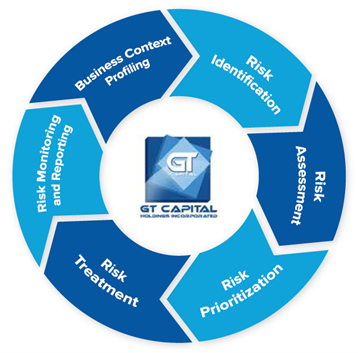
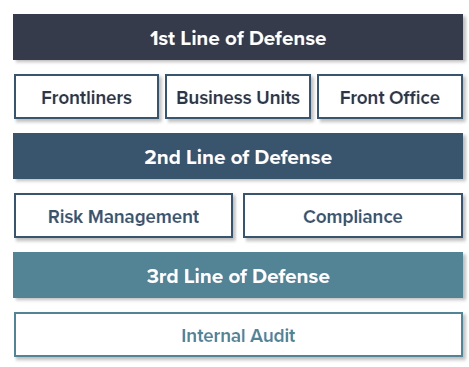
Risk Management Process
Risk Governance Structure
GT Capital’s risk governance structure ensures that risk management is not the sole responsibility of one individual but rather occurs and is supported at all levels in the Corporation. The effectiveness of the risk governance structure and process is supported by well-defined risk management roles and responsibilities and periodic review conducted by the Internal Audit Department.
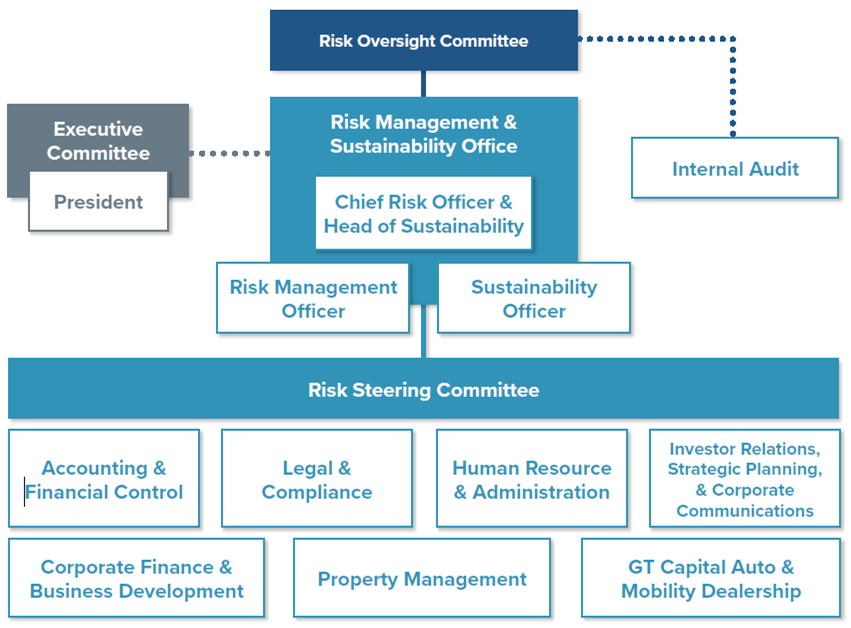
Risk Governance
The Board of Directors, through the Risk Oversight Committee, has the ultimate oversight role over the Corporation’s risk management activities, and approves risk management related policies, procedures, and parameters that govern the management of risks.
The Board of Directors, with guidance from the Executive Committee, determines the strategic direction of GT Capital and creates the environment and the structures to properly align risk management with strategic objectives.
The Chief Risk Officer (“CRO”) is the enterprise-wide risk advocate who facilitates the execution of the ERM process. His primary responsibility is to own, develop, implement, and continuously improve the ERM process. He is assisted by a full time risk management officer.
The Risk Steering Committee members are the risk owners composed of heads of departments who are responsible for the identification, assessment, and monitoring of key risks, and the establishment of countermeasures.
The Internal Audit Department provides an independent assurance of the effectiveness of the risk management process. In accordance with the Risk Charter, the risk management system is subjected to regular internal audits to identify any gaps in the performance of the process. The audit results are reported to Senior Management, the Audit Committee, and the Risk Oversight Committee, and are addressed accordingly.
Risk Appetite & Strategy
Risk Management’s goal is to provide a reasonable assurance regarding the company’s achievement of its core objectives of optimizing risk and return. To be value creating and effective, Risk Management must be embedded in and connected directly to the enterprise’s strategic planning process and execution. Aligned to this, the Risk Appetite Statements, with specific guiding thresholds and key metrics, are reviewed and approved by the Risk Steering Committee and the Risk & Sustainability Oversight Committee on an annual basis.
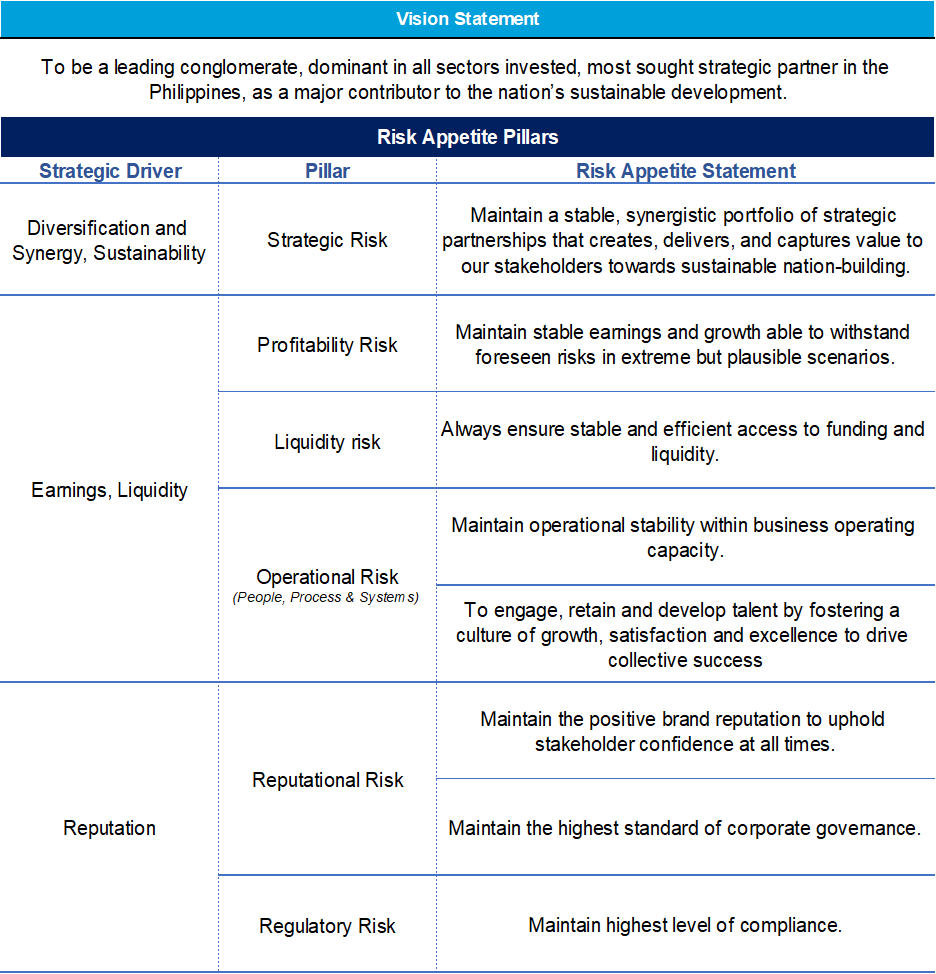
Risk Management Culture
Creating and promoting a risk culture that requires the highest standards of ethical behavior among all personnel is a must. This is achieved through the following:
- Transparent and consistent policies aligned with the risk appetite statements
- Pro-active engagement of first line of defense in risk management actions
- Promoting awareness among employees via culture building activities
- Onboarding process for employees
- Risk management KPIs in employee performance review
- Continuing education for all members of the organization
- Synergize learning opportunities across the Group for risk management
Prudent risk management played a vital role in GT Capital’s record performance and resilience amid the challenging year that was 2023. By anticipating and responding to the changes in its business environment, GT Capital continues to create and deliver value. It effectively puts up mechanisms that safeguard it from risk and enables it to maximize opportunities. The following section outlines the Company’s key risks alongside their likelihood, impact, and time horizon. It also discloses emerging risks that may arise in the next few years.
Risks And Opportunities
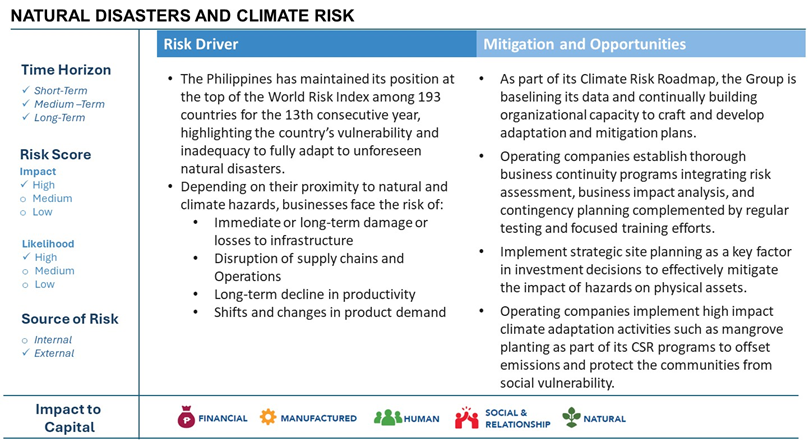
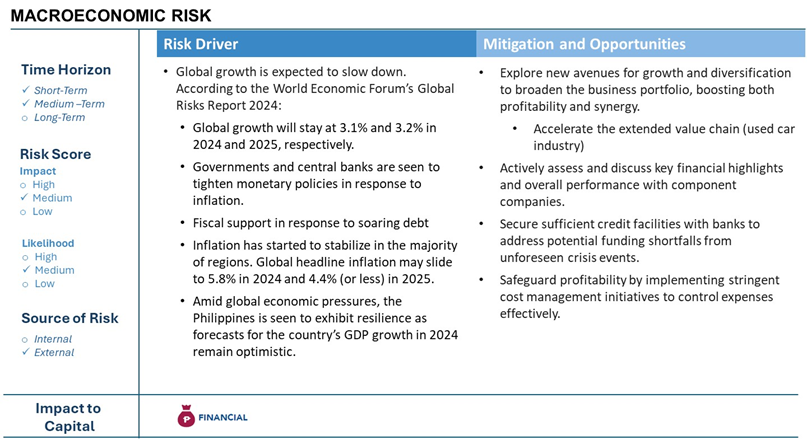
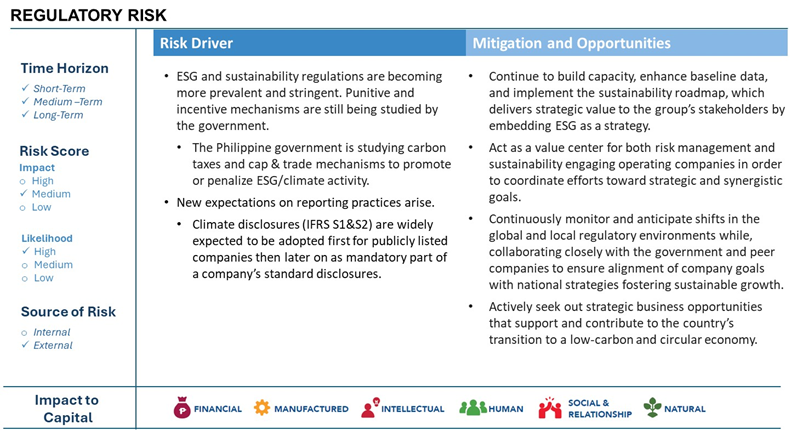
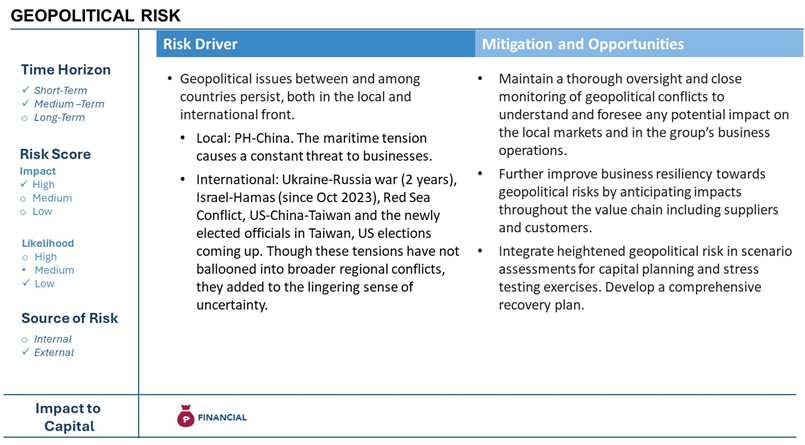
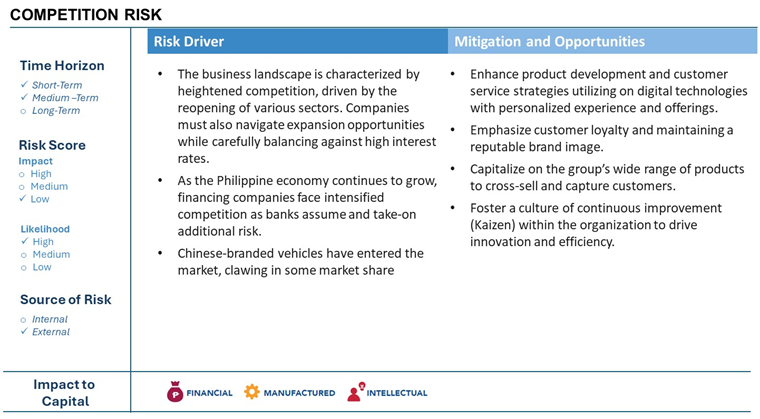
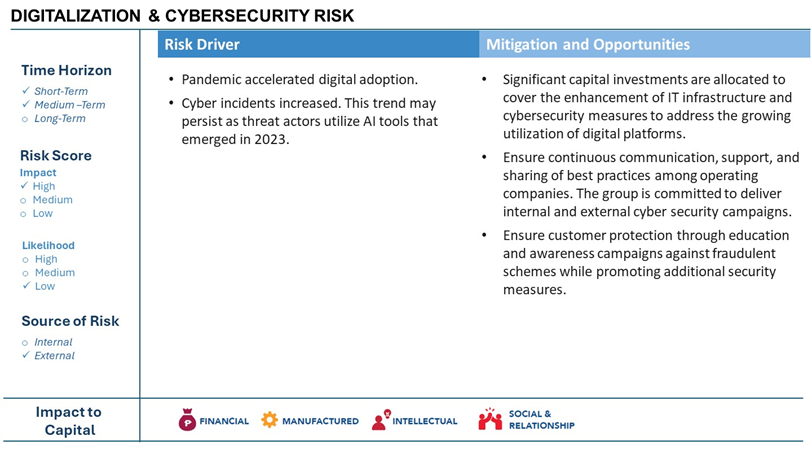
Emerging Risks
While navigating through current risks, GT Capital prepares itself for emerging risks at the same time. The Company considers a risk as “emerging” if it arises externally—from factors beyond its influence and control—and is getting increasingly important. While emerging risks are not projected to cause significant effects for the next 3-5 years, some consequences may have started to manifest already. These consequences may push the Company to modify its strategy in order to adapt.
Carbon Transition
| Context: | Our Response: |
| With policies becoming more stringent with regards to environmental impacts, businesses are impelled to lessen their carbon footprint. The Electric Vehicle Industry Development Act (EVIDA) has recently been signed into law as part of the Philippine government’s push to promote electric vehicles. However, the infrastructure required for EVs has not yet fully developed for mass adoption. EVIDA opens two possibilities for GT Capital and Toyota. First, an increase in customer demand may necessitate substantial investments in manufacturing facilities and supply chain to support EV production. Second, when EV charging infrastructure is in place, customer preferences may change and the Company may face stronger competition. | While the infrastructure to support fully Electric Vehicles (EVs) still hasn’t fully developed in the country, Toyota adds value as one of its several approaches to vehicle electrification that lead to carbon neutrality is by using hybrid technology. Toyota & Lexus hybrid line allows Filipinos to drive more sustainably by offering the widest range of Hybrid Electric Vehicles (HEV) in the market including Toyota’s Altis, Camry, Corolla Cross, RAV4, Yaris Cross, Alphard, and Zenix; and Lexus ES300h, IS300h, LS500h, NX350h, RX350h, RZ300e, RZ450e, UX250h, LM350h that make them lead the electrified market today. |
Energy Supply
| Context: | Our Response: |
| The Philippines’ energy supply issues are caused by an amalgamation of various factors such as increasing demand, dependence on fossil fuels, vulnerability to global market prices, susceptibility to natural disasters, disruption of supply chains and inadequate infrastructure investments. These may lead to power outages, especially during peak months. These may also result in decreased productivity and even compel the country to resort to carbon-intensive fuel sources to meet energy demands. |
The government is heavily investing in and integrating more renewable energy sources like solar and wind, as outlined in the Philippine Development Plan, where renewable energy remains a prioritized sector. This commitment is further emphasized by initiatives such as the Renewable Energy Act, which incentivizes investments in the sector. Efforts by the Department of Energy (DOE) and Energy Regulatory Commission (ERC) to boost capacity are evident through initiatives such as the Green Energy Auction Program, reflecting a concerted push towards sustainable energy development. Other notable projects include the Mindanao-Visayas interconnection project and the partnership for the floating solar projects on Laguna Lake. The company fully supports the nation’s development across critical sectors and is actively studying the renewable energy sector as part of its plan in diversifying into new business segments. |
Digital Information and Artificial Intelligence
| Context: | Our Response: |
| Businesses are increasingly becoming receptive to Artificial Intelligence (AI), looking for ways to integrate it into their operations. AI has shown promise in improving different areas of business including customer service, sales and marketing, and risk management, among others at low costs. However, adoption requires that a company must be adequately prepared to implement AI systems, lest it may be challenging to use. |
GT Capital and its operating companies have been strengthening their capacity to utilize advanced technology in the modernization of internal legacy systems, application of automation processes, development of mobile applications and utilizing analytics to enhance overall efficiency and user experience.
GT Capital has spearheaded numerous initiatives, such as roundtables, fostering synergy among experts within the group and in the industry to discuss topics encompassing digitization, analytics, and cybersecurity. Moreover, the Legal Council of the group has organized events to reinforce compliance and best practices on data privacy among companies within the Group. These initiatives are crucial in safeguarding against the rampant data breaches prevalent in today’s digital landscape. |
Workforce Demographic Change
| Context: | Our Response: |
| With the changes happening in the labor market, employers are pushed to think of strategies to retain talent. The rising cost of living forces people to continuously seek better opportunities—some of which are overseas, leading to labor shortage of skilled workers locally. Remote work is growing in popularity, opening possibilities for both employment and competition. Employers must also consider the younger workforce’s prioritization of their work-life balance. | GT Capital has mechanisms in place to ensure its employees’ satisfaction and professional growth. It invests in learning and development and offers programs that promote career advancement. The Company also gives its people the freedom to identify areas for improvement and express their needs through regular feedback mechanisms and open communication channels. |


